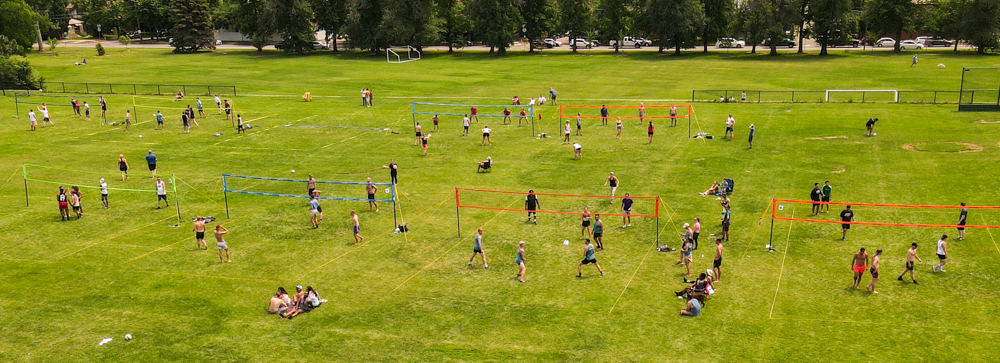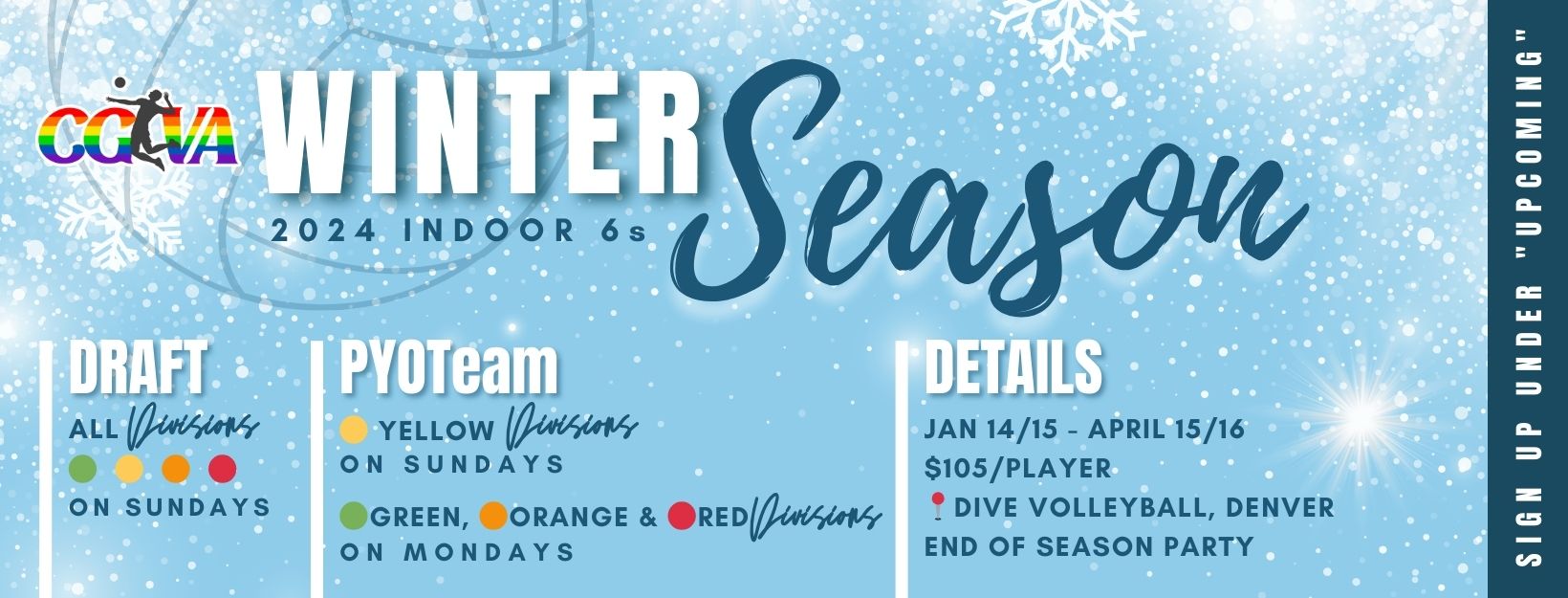
FORMAT
- MATCHES
- Pool play will consists of each team playing two-set matches within its pool, the results of which will be used to determine each team's "seed" in the tournament.
- The tournament may be single or double-elimination.
- Pool play will consists of each team playing two-set matches within its pool, the results of which will be used to determine each team's "seed" in the tournament.
- SCORING
- Pool play matches are comprised of two sets played to 21 using rally scoring (every time the ball is ruled dead results in a point). A team must win by at least two points with a cap of 23.
- Tournament matches are best-of-three sets. The first two sets will be played to 21 using rally scoring with a cap of 23. If the competing teams split the first two games, they will play a third and final game to 15 points with no cap (a team must win by at least two points).
- The final match will be best of three to 21, unless one of the teams hasn't lost before. Then, the competing teams will be required to play a final game to 21 with no cap (a team must win by at least two points).
- Consolation Bracket will play one set to 25 with no cap, win by two points.
- Pool play matches are comprised of two sets played to 21 using rally scoring (every time the ball is ruled dead results in a point). A team must win by at least two points with a cap of 23.
- TIME ALLOTMENT
- Matches have a 40 minute time limit. If time is called before the end of a match then the current score is final.
- Matches have a 40 minute time limit. If time is called before the end of a match then the current score is final.
- REFEREES
- Matches will be self-reffed.
- Team captains are active referees for their own team. Team players are to address their team captain for game play disputes. Team captains come together to make a final decision.
- If captains cannot settle game play disputes, team captains are to bring the dispute to the Tournament Directors immediately.
- Matches will be self-reffed.
- CANCELLATION
- In the event of inclement weather, the tournament cannot be rescheduled and refunds will not be given. If the weather results in a delay, play will resume once the weather has passed. If the weather results in cancellation, the prizes will be awarded to the teams with the best records during pool play or the teams with the highest ending scores during the tournament, depending on when the cancellation occurs.
RULES
- PLAYERS
- There are no penalties for a team with fewer than four players.
- SUBSTITUTION RULE:
Substitutions are only allowed with medical approval by tournament directors. Teams with fewer than four players may substitute players from other teams during pool play and the tournament provided those players are from the team's division. - To be eligible for tournament play as a sub or otherwise, a player must have played a minimum of one point during pool play.
- There are no penalties for a team with fewer than four players.
- GAME MANAGEMENT
- First serve will be determined by rock/paper/scissors (on 3, not after 3). The team that wins will have the choice of first serve or court, with the remaining choice going to the other team. Teams will switch both sides and server for the second game. For tournament matches, if a third game is necessary, rock/paper/scissors should be repeated before the third game.
- Teams are allowed up to two one-minute time-outs per game.
- First serve will be determined by rock/paper/scissors (on 3, not after 3). The team that wins will have the choice of first serve or court, with the remaining choice going to the other team. Teams will switch both sides and server for the second game. For tournament matches, if a third game is necessary, rock/paper/scissors should be repeated before the third game.
- ROTATION & SUBSTITUTIONS
- Players are not required to rotate positions during the course of play, but must serve in a consistent order.
- All players are considered front row the entire match. A player is able to hit in the front row even if he/she just served; there are no back-row attack violations.
- There is no limit to the number of substitutions allowed during a game.
- Players are not required to rotate positions during the course of play, but must serve in a consistent order.
- CENTER LINE & NET
- Touching any part of the net is a net fault.
- You may travel completely under the net, provided you make no contact with a player on the opposing team and do not interfere with the opposing team's play.
- Players cannot step into another court at any time and it is considered a dead ball, out of bounds.
- Touching any part of the net is a net fault.
- SERVICE
- "Let" serves, where the ball makes contact with the net on serve, are legal.
- Stepping on or over the line prior to making contact with the ball is a foot fault and loss of point.
- A player is allowed to let the ball drop to the ground (once per serving attempt) on a toss to serve. Catching a toss will result in a side-out.
- You may not prevent the opposing team, through screening, from seeing the server or the path of the ball. At an opponent's request, a player must move sideways, bend over, or bend down.
- You may not block or attack a serve.
- "Let" serves, where the ball makes contact with the net on serve, are legal.
- SETTING
- Sets must leave the setter's hands cleanly without multiple contacts on the ball. The NAGVA ball handling rules are in effect such that consideration may be given to setters due to the circumstance of the set and the level of play (A/AA, BB, B, Rec).
- A setter may set the ball over the net (forward or backward), provided his/her shoulders are perpendicular to the path of the ball. Side or directional sets are not permitted over the net. Side or directional sets are permitted when setting a fellow teammate on your side of the net.
- Sets must leave the setter's hands cleanly without multiple contacts on the ball. The NAGVA ball handling rules are in effect such that consideration may be given to setters due to the circumstance of the set and the level of play (A/AA, BB, B, Rec).
- GENERAL BALL HANDLING
- When a ball first crosses over the net after a serve and throughout a rally, the first hit MUST have player's hands together/touching and CANNOT open-hand set.
- A player MAY open-hand set a hard-driven attack (spike) in his or her attempt to dig that attack. An open-hand set with a slight double hit is acceptable if the ball is not controlled with any sort of carry.
- The first contact on the ball any time it comes over the net may be double-hit by a single player and still counted as a single contact provided that the double contact is made in one attempt to play the ball.
- The ball may be played with any part of the body.
- A touch on a block is not considered one of the three contacts allowed per team, nor does it prevent the blocker from making immediate secondary contact with the ball, which would be considered the first of the three contacts.
- You may not carry/lift the ball, which includes palming or throwing the ball on a hit.
- When contacting the ball with one hand, the ball must be cleanly hit with 1) the heel or palm of the hand (including roll shots), 2) straight, locked fingertips (cobra), or knurled fingers (camel-toe), 3) a closed fist, or 4) the back of the hand. One-handed placement or redirection of the ball with the fingers (dink or open-hand tip) is not permitted.
- You may not "roof" (blocker's hands extending over the net and breaking the plane of the net when the setter is setting the ball for an offensive play). A blocker may extend his/her hands over the net when 1) the ball is above the height of the net AND 2) is being attacked by the opponent (a hit or if the setter is dumping the ball).




